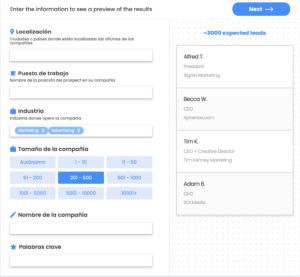Would we agree if we said how much the way we see the world has changed in the last two years? The way we interact, the way we run companies, and the way we make sales? Everything has been evolving very fast, and I’m sure you have too 😉.
That’s why today, from FindThatLead, we want to talk about the inside sales process, everything you need to consider when building a team, and the best tools you can use.
Shall we get started? 💙
What are the Inside Sales?
As the name implies, inside sales refers to sales activities that are conducted from the office.
Unlike field sales or outside sales, inside sales reps do not need to travel to meet with prospects and close deals. It includes prospecting and selling via phone calls, emails, text messages, video calls and LinkedIn. Sounds more convenient, doesn’t it? 😎
Blurred lines
When we said that the way we look at life has changed a lot we were referring for example to this fact: the line between inside and outside sales has blurred.
When the coronavirus pandemic occurred (we hate to write this word, sorry FindThatLeaders 😭) there was no choice but to execute online sales.
Broken perceptions
Previously, people believed that inside sales were for smaller deals. The perception was that in-person meetings were necessary to gain buyers’ trust.
But now, even in the B2B space (and in the high-price, high-velocity B2C sales space) customers are getting used to buying online.
Sales reps are successfully closing million-dollar deals via video calls. In addition, LinkedIn also reveals that 37% of respondents have closed deals of €500,000 or more without ever meeting the buyer in person!
Ventajas de una estrategia de Inside Sales
I love inside sales because of its scalability, both in terms of revenue and team.
The investment and budget to manage the teams is also low. Let’s look at some of the other benefits of the inside sales model.
1. Scalability
Once you figure out what works for your business and the math behind it, you can train ten more people to follow your sales strategy and succeed! 🥳
2. Profitability
It’s a very profitable business model. By not having travel and accommodation expenses, you can dedicate more time and money to establish scalable processes.
3. Time and resource efficient
Simply put, inside sales is more cost-effective than field sales.
Imagine having to travel to every potential customer’s office to try to have conversations about your product. What’s more, there’s a good chance they’ll turn you down and you’ll end up traveling there for nothing (unless you take advantage of it and take a little trip 😏). The salesperson would be spending time and money trying to sell.
However, with inside sales, you can sell in the comfort of your desks and if a potential customer is not available to talk, then all that is lost is a couple of minutes.
4. Streamlined and more transparent
Everything moves faster in inside sales. You can test existing processes, incorporate a new one, A/B test both and make changes to the existing process, all very quickly!
5. Easier to manage
This is a great advantage for sales managers. Most field sales teams are spread across different locations, either nationally or internationally.
This makes it somewhat difficult to control them. However, an inside sales team can be in the same location, which makes your job easier.
6. Predicting revenue
Inside sales follows a very analytical approach. You know how many calls individual reps need to make or how many demos they need to book per day to reach the target.
Knowing these numbers and tracking them meticulously will help you predict revenue and plan a future-proof strategy.
Inside sales is a volume game. You must know your numbers down to the smallest detail. And since you can measure everything in inside sales, you can make changes and improve the process frequently!
Inside Sales Process and Team Structure
Did you know that companies with sales teams dominated by inside sales reps have 9.8% higher quota compliance than companies dominated by outside sales reps (source)?
The HubSpot Sales Enablement Survey 2021 found that 64% of sales leaders who transitioned to remote work sales in 2020 met or exceeded their sales goals.
McKinsey also reports that prior to the pandemic, 52% of B2B decision makers preferred traditional sales interactions. Today, 66% prefer virtual sales interactions.
The above statistics reflect why you should invest in an inside sales team. But then, how do you set it up to work properly? 🧐
Having an inside sales team without a process in place will not give you better results than blindly going out into the field selling 😉.
So let me help you understand exactly how you can set it up and the different stages of the inside sales process.
The inside sales process
For your inside sales process to run smoothly, you need to have a few essential components. These include:
- A smart inside sales team
- A good contact tool
- A smart CRM tool
- An integrated analytics tool
Like a recipe, the above list can be thought of as the ingredients you need to prepare before you start cooking. You’ve got the components ready? Now let’s get cooking! 👨🏽🍳
1. Attracting potential customers
Clearly, the first step for the sales team to work is to have a good list of potential customers to target.
In the past, you used to contact people at random and try to sell products. Nowadays this doesn’t seem a very good idea, does it? 😣
That’s why we encourage you to use one of the best tools to capture leads: Scrab.in! I’ll show you how it works in a moment.
Just sign up for the tool, log into LinkedIn and filter your target audience. Now, enter the tool’s dashboard and activate the visits. And finally… Just fire up Scrab.in and relax, have a beer or a nice tea (yes, it will do all the work) 😏.
2. Lead qualification
Your inside sales team must also know how to qualify and prioritize leads. Not every lead that contacts your company is going to buy from you.
Some may simply be curious, or some are random leads that came in by mistake. Your inside salesperson can’t be calling all of them and wasting their time when you can be pursuing more important leads.
That’s why it’s important to have a tool like Prospector, which will generate a very precise audience list that has the ability to fully adapt to your lead’s personality.

3. Contacting potential customers
This is where your Cold Email tool comes into play. You must be able to make easy, personalized contact with your lead list.
Simply sign up for the tool and start launching ultra-personalized and automated email campaigns that convert 100%!
Here are the following tips:
- Write an intriguing subject line
- Write short emails: make your message short and with a value proposition.
- Make a clear message
- Personalize the subject and the body of the message with the recipient’s name.
4. Closing the deal
This is the icing on the cake, the goal you’ve been working towards.
Get your prospects to cough up their money in exchange for your product or service. Okay, that sounds crude, but you know what I mean? Closing a deal is the sweet spot for any salesperson, and this should be the last step for an inside salesperson before handing it over to the customer success team 🎂💙.
How to build a successful Inside Sales team
1. Provide training
Even if you hire an experienced professional, sales and product training is crucial!
Sales training is important for reps to become familiar with your culture and process. And product training, of course, is necessary to help them better understand your product/service and its USP.
⭐ Tip: You can also train your team members to follow the sales techniques of your best salespeople.
2. Track metrics and improve your process regularly.
You can’t improve what you can’t measure. Monitor your sales metrics. Identify what is holding you back from achieving your goals: whether it’s lead quality, the fit gap, the competition, or the market.
⭐ Tip: Develop strategies to overcome these challenges.
3. Automate as much as you can
Automation is the foundation of a scalable business.
⭐ Tip: Identify manual processes where your team members are spending time that could be better spent elsewhere. Find out if there is a way to automate this process.
4. Align sales and marketing
Sales reps are the ones who interact with buyers. They can bring practical knowledge to marketing.
⭐ Tip: Use their expertise to craft your marketing message.
For example, when your sales reps identify a buyer challenge that can be solved with your product/service, let the marketing team write blogs around it.
Share them on social media and distribute them through Cold Email campaigns. This way, you’ll be reinforcing your inbound source and buyer inquiries will automatically start coming in.
⭐ Tip: Make sure the message is consistent across all teams. Marketing people must know what is going on in sales, the market they are trying to penetrate, the profile of the ideal customer, the buyer persona, etc.
5. Invest in technology tools
If you think a certain software can make your reps’ lives easier, do it! Apart from the Cold Email and Prospector tool, we use other tools that will facilitate any sales process and even Inside Sales, visit us and be amazed at what you can achieve! 😎







 BONUS:
BONUS: The Challenge: Join this free course and I guarantee that after 5 days you will have the necessary skills to start generating B2B clients Growth Hacking and Prospecting techniques.
The Challenge: Join this free course and I guarantee that after 5 days you will have the necessary skills to start generating B2B clients Growth Hacking and Prospecting techniques.